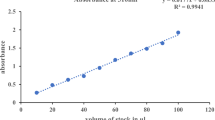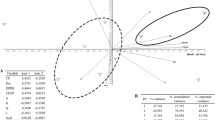Abstract
Native Crocus taxa are abundant in regions with moderate and dry climate; however, their potential in the food industry has thus far been neglected. The objective of this study was to compare the quantitative and qualitative flavonoid content and antioxidant and cytotoxic activity in organs of several populations of Croatian native taxa and assess their potential for application in the food industry. The dominant flavonoids in the native Crocus taxa were kaempferol and quercetin. Tepals contained similar or higher concentrations of flavonoid-glycosides than other organs. Tepals from Cvv1 and Cvv2 populations contained more flavonoid-glycosides than the commonly used spice saffron (C. sativus stigmas). The FRAP antioxidant activity of Cvv1 and Cvv5 tepals was similar to that of standard Trolox. DPPH inhibition of Cvv1 and Cvv3 tepals was within the range of that recorded for saffron. Cvv1 tepals significantly reduced reactive oxygen species in the broadest concentration range (50–1000 μg/ml), and showed considerable antioxidant activity in the ABTS assay, equal to 82% of standard Trolox antioxidant activity. A significantly higher concentration of kaempferol-rutinoside was recorded in this than in other taxa. The flavonoid showed a very strong or strong correlation with antioxidant assays results, and a negative correlation with cellular reactive oxygen species concentration. We therefore presumed that kaempferol-rutinoside is one of the main antioxidant phenolics in Crocus tepals. None of the tested extracts showed cytotoxicity toward Caco-2 cells. The results revealed that Cvv tepals have potential as a food supplement and are a promising material for further food safety tests.



Similar content being viewed by others
Abbreviations
- ABTS:
-
2,2′-azinobis(3-ethylbenzothiazoline-6-sulfonic acid)
- Cm:
-
Crocus malyi (location North Velebit)
- Cs:
-
Crocus sativus
- Cva:
-
Crocus vernus ssp. albiflorus (location Jelenje, Delnice)
- Cvv1:
-
Crocus vernus ssp. vernus (location Botanical Garden, Zagreb)
- Cvv2:
-
Crocus vernus ssp. vernus (location Čulinec, Zagreb)
- Cvv3:
-
Crocus vernus ssp. vernus (location Grad mladih, Zagreb)
- Cvv4:
-
Crocus vernus ssp. vernus (location Čazma)
- Cvv5:
-
Crocus vernus ssp. vernus (location North Velebit)
- DCFDA:
-
2′,7′-dichlorofluorescin diacetate
- DPPH:
-
1,1-diphenyl-2-picrylhydrazyl
- FRAP:
-
ferric reducing antioxidant power
- K:
-
kaempferol
- K-rut:
-
kaempferol-rutinoside
- Q:
-
quercetin
- Q-digluc:
-
quercetin-3,4`-di-O-glucoside
- Q-gluc:
-
quercetin-glucoside
- ROS:
-
reactive oxygen species
- tot. aglyc.:
-
total aglycones
- tot. glyc.:
-
total glycosides
References
Moratalla-López N, Lorenzo C, Alonso GL, Sánchez AM (2016) Kaempferol glycosides in Crocus: sources, biosynthesis, and uses. In: Garde-Cerdán T, Gonzalo-Diago A (eds) Biosynthesis, food sources and therapeutic uses, 3rd edn. Nova Science Publishers, New York, pp 151–196
Petersen G, Seberg O, Thorsøe S, Tina Jørgensen T, Mathew B (2008) A phylogeny of the genus Crocus (Iridaceae) based on sequence data from five plastid regions. Taxon 57:487–499
Moure A, Cruz JM, Franco D et al (2001) Natural antioxidants from residual sources. Food Chem 72:145–171
Boskabady MH, Farkhondeh T (2016) Antiinflammatory, antioxidant, and immunomodulatory effects of Crocus sativus L. and its main constituents. Phytother Res 30:1072–1094
Zeka K, Ruparelia KC, Continenza MA, Androutsopoulos VP, Vegliò F, Arroo RRJ (2015) Petals of Crocus sativus L. as a potential source of the antioxidants crocin and kaempferol. Fitoterapia 107:128–134
Srivastava R, Ahmed H, Dixit RK, Dharamveer SSA (2010) Crocus sativus L.: a comprehensive review. Pharmacogn Rev 4:200–208
Termentzi A, Kokkalou E (2008) LC-DAD-MS (ESI+) analysis and antioxidant capacity of Crocus sativus petal extracts. Planta Med 74:573–581
Goli SAH, Mokhtari F, Rahimmalek M (2012) Phenolic compounds and antioxidant activity from saffron (Crocus sativus L.) petal. J Agric Sci 4:175–181
Serrano-Díaz J, Sánchez A, Maggi L et al (2012) Increasing the applications of Crocus sativus flowers as natural antioxidants. J Food Sci 77:1162–1168
Ordoudi SA, Tsimidou MZ (2004) Saffron quality: Effect of agricultural practices, processing and storage. In: Dris R, Mohan Jain S (eds) Production practices and quality assessment of food crops. Volume 1 – Preharvest practice. Kluwer Academic Publishers, Dordrecht, pp 209–260
Harborne JB, Williams CA (1984) 6-Hydroxyflavones and other flavonoids of Crocus. Z Naturforsch 39:18–23
Li A-N, Li S, Li H-B, Xu D-P, Xu X-R, Chen F (2014) Total phenolic contents and antioxidant capacities of 51 edible and wild flowers. J Funct Foods 6:319–330
Poljuha D, Šola I, Bilić J, Dudaš S, Bilušić T, Markić J, Rusak G (2015) Phenolic composition, antioxidant capacity, energy content and gastrointestinal stability of Croatian wild edible plants. Eur Food Res Technol 241:573–585
Brkanac SR, Gerić M, Gajski G, Vujčić V, Garaj-Vrhovac V, Kremer D, Domijan AM (2015) Toxicity and antioxidant capacity of Frangula alnus Mill. bark and its active component emodin. Regul Toxicol Pharmacol 73:923–929
Repetto G, Del Peso A, Zurita JL (2008) Neutral red uptake assay for the estimation of cell viability/cytotoxicity. Nat Protoc 3:1125–1131
Yang HW, Hwang KJ, Kwon HC, Kim HS, Choi KW, Oh KS (1998) Detection of reactive oxygen species (ROS) and apoptosis in human fragmented embryos. Hum Reprod 13:998–1002
Baba SA, Malik AH, Wani ZA et al (2015) Phytochemical analysis and antioxidant activity of different tissue types of Crocus sativus and oxidative stress alleviating potential of saffron extract in plants, bacteria, and yeast. S Afr J Bot 99:80–87
Ahmadian-Kouchaksaraie Z, Niazmand R, Najafi MN (2016) Optimization of the subcritical water extraction of phenolic antioxidants from Crocus sativus petals of saffron industry residues: Box-Behnken design and principal component analysis. Innov Food Sci Emerg Technol 36:234–244
Nørbæk R, Brandt K, Kvist Nielsen J, Ørgaard M, Jacobsen N (2002) Flower pigment composition of Crocus species and cultivars used for a chemotaxonomic investigation. Biochem Syst Ecol 30:763–791
Karimi E, Oskoueian E, Hendra R, Jaafar HZE (2010) Evaluation of Crocus sativus L. stigma phenolic and flavonoid compounds and its antioxidant activity. Molecules 15:6244–6256
Koh E, Wimalasiri KMS, Chassy AW, Mitchell AE (2009) Content of ascorbic acid, quercetin, kaempferol and total phenolics in commercial broccoli. J Food Compost Anal 22:637–643
Ryan KG, Swinny EE, Markham KR, Winefield C (2002) Flavonoid gene expression and UV photoprotection in transgenic and mutant Petunia leaves. Phytochemistry 59:23–32
Assimopoulou AN, Sinakos Z, Papageorgiou VP (2005) Radical scavenging activity of Crocus sativus L. extract and its bioactive constituents. Phytother Res 19:997–1000
Natoli M, Leoni BD, D'Agnano I, D'Onofrio M, Brandi R, Arisi I, Zucco F, Felsani A (2011) Cell growing density affects the structural and functional properties of Caco-2 differentiated monolayer. J Cell Physiol 226:1531–1543
Gismondi A, Serio M, Canuti L, Canini A (2012) Biochemical, antioxidant and antineoplastic properties of Italian saffron (Crocus sativus L.). Am J Plant Sci 3:1573–1580
Sánchez-Vioque R, Santana-Méridas O, Polissiou M et al (2016) Polyphenol composition and in vitro antiproliferative effect of corm, tepal and leaf from Crocus sativus L. on human colon adenocarcinoma cells (Caco-2). J Funct Foods 24:18–25
Carocho M, Ferreira IC (2013) A review on antioxidants, prooxidants and related controversy: natural and synthetic compounds, screening and analysis methodologies and future perspectives. Food Chem Toxicol 51:15–25
Evans JD (1996) Straightforward statistics for the behavioral sciences. Brooks/Cole Publishing, Pacific Grove
Acknowledgments
The authors thank Ksenija Durgo and Dario Hruševar for help with cytotoxic test and collecting part of the plant material in this study. The study was financially supported by the University of Zagreb (Grants No. 20281217 and 000070002401), Croatia.
Author information
Authors and Affiliations
Corresponding author
Ethics declarations
Conflict of Interest
The authors declare that they have no conflict of interest.
Rights and permissions
About this article
Cite this article
Šola, I., Stipaničev, M., Vujčić, V. et al. Comparative Analysis of Native Crocus Taxa as a Great Source of Flavonoids with High Antioxidant Activity. Plant Foods Hum Nutr 73, 189–195 (2018). https://doi.org/10.1007/s11130-018-0674-1
Published:
Issue Date:
DOI: https://doi.org/10.1007/s11130-018-0674-1




